 UWindsor biologist Barbara Zielinski and team. From left to right:
Front row: Gillian Hughes, Dr. Barbara Zielinski, Jenna Jones, Kaela Scott, Dr. Michelle Nevett.
Back row: Tina Suntres, Georgette Nader, Gianfranco Grande, Alexandra Zygowska, Karl Boyes.
UWindsor biologist Barbara Zielinski and team. From left to right:
Front row: Gillian Hughes, Dr. Barbara Zielinski, Jenna Jones, Kaela Scott, Dr. Michelle Nevett.
Back row: Tina Suntres, Georgette Nader, Gianfranco Grande, Alexandra Zygowska, Karl Boyes.
A UWindsor biologist and the students who work in her lab are eager to outsmart the invasive sea lamprey using pheromone research that could help deal with this eel-like fish in the Great Lakes.
“They spawn in waterways, such as creeks and rivers where other lampreys already live,” says Barbara Zielinski, biology and GLIER professor.
“The lampreys signal to each other with pheromones. The immature larval sea lamprey living in these waterways release chemical compounds from the liver, which emits a strong smell to indicate favourable habitat to migrating adult sea lampreys that are ready to reproduce. Once these migrating lampreys have chosen a waterway for spawning, the males build a nest and release pheromones that attract females.”
Dr. Zielinski’s lab recently received a nearly $300,000 grant from the Great Lakes Fishery Commission (GLFC), that they will share with a research partner lab at The Université de Montréal, to conduct cellular neurological research. It is all to understand which of the fish’s brain cells are responding to both the previously discovered and newly discovered pheromones, as well as the motor responses that these chemical smells trigger, so her team can develop ways to intercept the sea lamprey before it mates and reproduces.
Sea lamprey spawn in rivers and streams and then die. For the first few years of their lives they live fairly harmoniously with other aquatic life by filter feeding on dead organic matter.
It is when they metamorphose and move into the Great Lakes that they become harmful parasites that like to sink their teeth into native fish and suck their blood like a vampire. This leaves native fish with an unsightly wound that is susceptible to infection.
Zielinski’s lab studies olfactory sensory neurons and the olfactory bulb, which is a brain region that organizes the brain's response to odors.
“We started mapping how this olfactory area of the brain is wired and have found that pheromones stimulate two regions,” says Zielinski.
“Until now there was only a small window of opportunity for testing during spawning season, but we can take out the brain and test pheromone responses directly.”
Previous lamprey population management relied on erecting barriers to intercept migration, or the introduction of chemicals fatal to lamprey into rivers and streams where larvae live. Because these options impact other aquatic life, pheromone research has the potential to be a valuable tool in targeting lamprey populations without harming other life.
Sea Lamprey first expanded their domain from oceans into the Great Lakes during the first part of the 20th century along newly opened shipping channels. In the last decade or so, there has been a conscious effort to improve habitat for native fish along the dredged shipping routes and that is when we have started to see sea lamprey larvae on the rise again, including the Detroit River.
“It is important to control these populations,” says Zielinski.
“This research into using biological tools for population management, is amongst the most promising strategies to affect or disrupt migration or reproduction of sea lampreys without affecting other organisms.”



